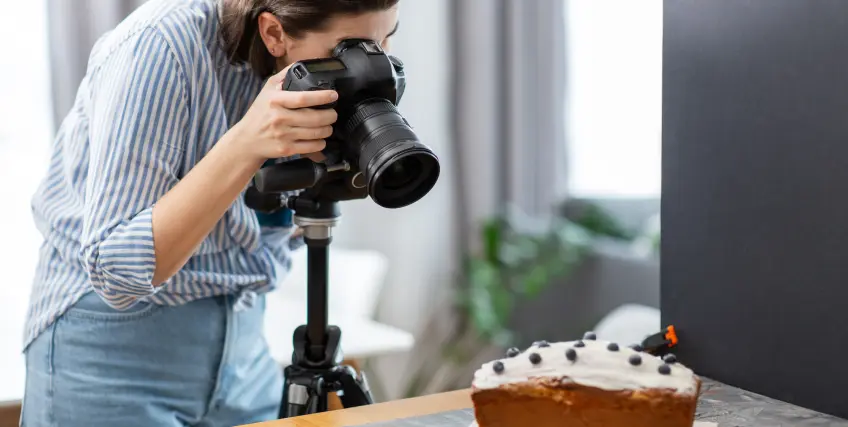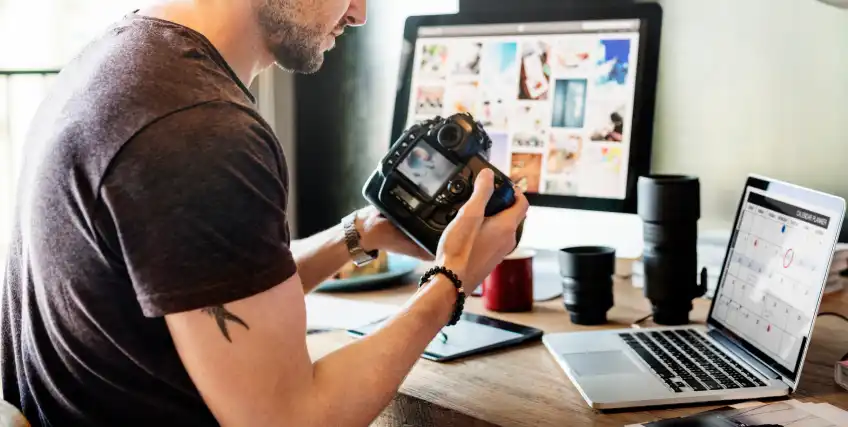Fund Your Next Shoot
With a Smart Photography Business Loan.
Need Financing for Your Business?
Biz2Credit has commercial financing products, such as term loans and revenue-based financing, that help your business grow.
Apply OnlineSet up a Biz2Credit account and apply for business financing
Photography isn’t just about capturing moments anymore; it’s a full-scale business. From managing gear to growing a client base, photographers today wear many hats. But building a sustainable studio or freelance operation isn’t cheap. Whether it’s investing in high-end equipment, renting studio space, or advertising your services, costs can stack up fast.
That’s where a photography business loan comes in. It’s not just about buying a camera. It’s about giving your business the capital to grow. Many professional photographers, especially those running solo or small teams, explore small business loans for photographers to meet expenses or expand operations.
Options like an SBA loan for photographers or other business loans for business expenses can help bridge the gap when revenue is delayed or seasonal. Even established professionals can face cash crunches between gigs or large projects.
A loan gives you breathing room and the freedom to focus on creativity, not cash flow. If you’re ready to get business financing, it’s worth knowing what’s out there. From one-time upgrades to ongoing working capital needs, business loans for photographers can make the difference between staying afloat and scaling up.
Why Photographers Need Financing
If you ask any working photographer about the photography business, they will all tell you – this business isn’t just about taking great photos. It’s about managing a studio, juggling client deadlines, maintaining equipment, and staying ahead in a competitive industry. And all of that requires money.
A photography business loan can help cover the many upfront and ongoing costs that come with running a studio or freelance operation. First, there’s the gear. Cameras, lenses, lighting, editing setups – none of them come cheap. Then there’s the cost of maintaining or renting studio space, purchasing props, updating software licenses, and keeping up with backups and storage systems.
If you’re growing, you may need to hire staff like an assistant, a marketing person, or even a freelance editor. That adds to your payroll and monthly outflow. Then comes promotion. Whether you’re boosting your brand on social media or building a professional website, marketing can eat up a chunk of your budget.
And let’s not forget the seasonal fluctuations. Many photographers experience slow months, especially if they rely on weddings, events, or outdoor shoots. When the income slows but expenses stay steady, business loans for photographers can help smooth over the bumps.
Being able to get business financing when you need it can mean the difference between taking on bigger gigs or turning them down. A smart photography business loan lets you act when opportunity strikes, rather than waiting until you have enough saved up.
Popular Uses of Photography Business Loans
There’s no single formula for how to use a photography business loan. The right move depends on what stage you're in and where you want to go next. From essential upgrades to scaling operations, here are five of the most common and practical uses.
1. Equipment Upgrades
Your gear is your business. Cameras, lenses, drones, lighting setups, and editing software are constantly evolving. Staying competitive means keeping up. But the costs? They can run into thousands.
A photography business loan helps cover the expense without draining your savings. Whether you're replacing outdated tripods or upgrading to a full-frame mirrorless system, loans offer a way to invest in high-quality photography equipment upfront and pay it off gradually. It’s an especially smart move if your work relies on delivering top-tier image quality to high-end clients.
2. Studio Expansion or Renovation
Outgrowing your space? Or thinking of launching a physical studio for walk-in clients or corporate shoots? Studio setups are expensive. From flooring to backdrops and controlled lighting systems, every element adds up.
Using a photography business loan to fund a renovation or expansion lets you create a better client experience without disrupting cash flow. Some photographers also invest in building soundproof areas for video shoots or adding editing bays. This is where business loans for business needs really come into play, especially when you’re trying to scale up without waiting for months of savings.
3. Marketing and Social Media
It’s not enough to take great photos. People need to see your work. Digital ads, portfolio websites, Instagram campaigns - all require investment.
A photography business loan can be used to build a proper marketing plan. Maybe you want to hire a consultant to sharpen your messaging or pay for professional branding. Whether you’re running Facebook ads or creating behind-the-scenes reels, putting money behind your reach can land better-paying gigs and recurring clients. That makes marketing not just an expense but a growth engine.
4. Managing Seasonal Cash Flow
Photography isn’t always steady. Some months are packed with bookings; others are painfully quiet. That kind of income variability can mess with your rent, payroll, or monthly software bills.
A photography business loan gives you the cushion to survive slow periods while prepping for busier seasons. Many studio owners use working capital loans to handle off-season costs like retaining staff or prepping equipment for peak periods. Instead of feeling stuck when the work dries up, you’ll be ready to invest in your business year-round.
5. Hiring Staff or Freelancers
Eventually, you’ll hit the ceiling trying to do it all yourself. Retouching, client calls, shooting, and editing -it’s too much for one person.
That’s when a photography business loan can help you bring others on board. Maybe it’s a part-time assistant, a freelance editor, or someone to handle bookings and follow-ups. Delegating lets you focus on the shoots that actually make you money. Hiring is a business decision and using outside funds gives you the freedom to grow your team without waiting for a cash surplus.
Types of Photography Business Loans
Not every photography business loan works the same way. The right fit depends on how much you need, how fast you need it, and how long you plan to repay it. Let’s break down the most common financing options photographers explore today.
1. SBA Loan for Photographers
If you’ve got strong credit and time on your side, an SBA loan for photographers can be one of the most affordable choices. Backed by the Small Business Administration, these loans often come with low interest rates and longer repayment terms.
They're especially good for larger investments like setting up a commercial studio or buying high-end gear in bulk. But be prepared: the application process can take weeks and requires detailed paperwork. If you’re willing to wait and qualify, SBA loans can offer major long-term value for your photography business loan needs.
2. Short-Term Loans
Need fast funding for an upcoming shoot or urgent repair? Short-term business loans are a common fix. These are quick to apply for, often approved within days, and come with a fixed repayment period, usually under 18 months.
They’re great when you know exactly how the money will be used, like covering a down payment for a studio or replacing damaged equipment. Just keep in mind: since the loan is repaid quickly, monthly payments can be higher. Still, for many professional photographers, the speed and simplicity make this an appealing photography business loan option.
3. Equipment Financing
This one’s built specifically for your tools of the trade. Instead of paying upfront for photography equipment, equipment financing lets you spread the cost out over time.
It’s often easier to qualify for than other business loans, since the gear itself acts as collateral. You keep your liquidity while getting the tools you need right away. For photographers who consistently reinvest in new technology, this is a smart way to stay current without tapping into the working capital.
This form of photography business loan focuses entirely on gear and nothing else.
4. Business Line of Credit
Think of this as a financial safety net. A business line of credit gives you access to a pool of funds, which you can tap into as needed. You only pay interest on what you use and not the full amount.
Photographers often use this for managing cash flow between gigs, covering unexpected costs, or ramping up during the busy season. It offers flexibility, making it one of the most versatile financing options available.
For businesses with fluctuating incomes, a line of credit is often more useful than lump-sum loans. It works well as a backup, especially if you’ve already secured a photography business loan for bigger expenses.
5. Merchant Cash Advance
This isn’t technically a loan but it works similarly. A merchant cash advance gives you upfront cash in exchange for a portion of future sales. It’s fast and typically doesn’t require perfect credit.
For photographers who get paid digitally or via credit card, it can be a way to access money quickly. The downside? It’s often more expensive than traditional loans, and daily deductions can impact cash flow.
Still, for those tight moments when a photography business loan isn’t available fast enough, this option fills the gap. Just be sure to read the terms carefully.
How to Prepare Before Applying
Getting approved for a photography business loan isn’t just about needing the money; it’s about showing you can use it responsibly. The stronger your paperwork and preparation, the better your chances of getting approved on good terms.
Start with the basics. Make sure your business name is officially registered and that you have a dedicated bank account for business finances. Lenders want to see a clear separation between personal and business funds. You’ll also need to gather your financial documents such as tax returns, bank statements, income reports, and expense summaries.
Next, check your credit score. Many lenders consider both personal and business credit histories, especially for small photography businesses or sole proprietors. If your score needs work, consider paying down credit card balances or resolving any outstanding issues before applying.
A detailed business plan also helps. It should outline how you plan to use the loan, how it supports your growth goals, and how you’ll handle repayment. For example, if you're requesting $20,000 to build a new studio, lay out expected expenses, revenue projections, and a timeline for completion.
Don't forget the extras: a valid ID, proof of address, recent invoices or bookings, and a working phone number tied to your business. These small things can speed up the loan application process.
Being well-prepared doesn’t just help you secure funding. It shows lenders that you’re running a serious, organized operation. That alone can improve your odds of getting the photography business loan you need.
What Lenders Look For
Applying for a photography business loan is one thing and getting approved is another. Every lender has a slightly different process, but most are evaluating a few key areas to decide whether your business is a smart bet.
First, they look at your time in business. If you’ve been operating for at least 1–2 years and show consistent income, you’re already ahead. Lenders like stability. If you're new, they’ll want to see strong future bookings or a clear revenue plan.
Next, your credit score matters. A high score shows you manage money well and aren’t a repayment risk. But even if your score isn’t perfect, other factors like growing revenue or an expanding client list can help your case.
Repayment history is a big one. If you’ve taken out loans before and repaid them on time, that builds trust. No history? That’s not a deal-breaker, but lenders may be more cautious.
Your financials tell the rest of the story. Monthly revenue, profit margins, and current debts all affect how much you can borrow and at what interest rates.
Some lenders also look at your studio setup, equipment list, website, and social media presence. This is because these paint a picture of how serious and marketable your photography business really is.
In short, getting a photography business loan isn’t just about your numbers. It’s about proving your business has traction, professionalism, and the potential to grow.
Alternatives to Business Loans
A photography business loan isn’t your only option when you need capital. If you’re not ready to take on debt or don’t yet qualify, there are other funding options worth exploring. These alternatives can help bridge short-term gaps or support long-term growth without formal lending.
1. Photography Grants
Grants from arts organizations or local government programs are often overlooked. They don’t require repayment, making them ideal if you qualify. Look into national and state-level grants for small business creatives. While competitive, they can cover gear, marketing, or education expenses with no strings attached.
2. Credit Unions
Local credit unions may offer better rates and more flexible terms than big banks. They tend to work closely with community-based entrepreneurs, including photographers. If you have a relationship with one or are open to joining, they might provide funding when traditional lenders won’t.
3. Peer Partnerships
Sometimes, another photographer or small business owner may be open to sharing resources. Whether it’s co-renting a studio or sharing gear, partnerships can help you scale without debt. It won’t give you full capital, but it can reduce your costs significantly.
4. Pre-Booking Clients
Offer clients a discount on booking in advance. This approach brings in upfront cash while locking in future work. Many photographers use this strategy to raise capital before buying new gear or launching a campaign; no loan needed.
5. Crowdfunding or Sponsorship
If you have a strong client base or online presence, consider running a small crowdfunding campaign. You can also seek local sponsorship from vendors you work with. These creative funding options are especially useful for launching new services or personal photography projects.
Trusted by Thousands of Small Business Owners in America.**
Simply because we get what you go through to build a business you believe in.
**Disclaimer: All stories are real, as told by real business owners. Customers do not receive monetary compensation for telling their stories.
From One Entrepreneur to Another: We Get You
We understand what's behind building a business you believe in.
All stories are real, as told by real business owners. Customers do not receive monetary compensation for telling their stories.



Articles on Loans for Photography Business
How to Start a Photography Business and Get the Financing You Need
If you enjoy capturing the best moments of someone’s life on camera, you’ve probably thought about becoming a professional photographer
Guide to Business Loans for Photographers
For a creative industry, photography can also require significant investment in equipment, marketing, software, studio space, and travel
Business Loan Options for Professional Photographers in 2025
For professional photographers, passion and talent are just two pieces of the small business puzzle. If you want to grow your photography
Frequently Asked Questions
1. What’s the difference between equipment financing and a general photography business loan?
A photography business loan can be used for anything like rent, payroll, and marketing. Equipment financing, however, is just for gear. It's usually easier to qualify for since the gear itself secures the loan. If you only need a new camera or lighting kit, equipment financing might be a faster, lower-risk option.
2. Will getting a loan hurt my cash flow?
It depends on how well you plan. A photography business loan should support your operations, not strain them. Budget for monthly payments based on your typical income. If you take on too much debt or slow months aren’t accounted for, yes, cash flow can get tight. A realistic repayment strategy is key.
3. What do lenders look at when I apply for a loan?
Most lenders consider your credit score, monthly revenue, and how long you’ve been in business. But they also check your repayment history and your ability to handle debt responsibly. Some even review your online presence, social media, and booking trends, especially in creative industries like photography.
4. Can I use a photography business loan for marketing and branding?
Promoting your studio, running social ads, or building a website are all valid uses. In fact, many photographers use business loans for business growth because visibility directly affects bookings. Just be sure your marketing investment is backed by a plan to convert interest into revenue.
5. Do I need business insurance before applying for a loan?
While not always required, having business insurance can improve your loan application. It shows you’re protecting your equipment and operations, which lenders appreciate. It’s especially useful if you’re applying for larger loans or operating from a physical studio space.



